In the world of woodworking, precision and efficiency are crucial. When it comes to cutting materials to the perfect length, two names often come up in the conversation: Razorgage and Tigerstop. Both of these brands have their respective fan bases, and for good reason. They each offer their unique set of advantages that cater to different needs and preferences.
So, how do you choose between the two? In this article, we will dive deep into the world of Razorgage and Tigerstop, comparing their features, pros, and cons to help you make an informed decision.
The Story of Razorgage

Razorgage, a product by RazorGage, is an automatic saw system that boasts incredible precision and efficiency. With a robust design and user-friendly interface, Razorgage has made a name for itself in the woodworking industry.
Pros of Razorgage
- Ease of use
Razorgage systems are designed with user-friendliness in mind. Their touch-screen interface is intuitive and easy to navigate, making it simple for operators of all experience levels to get started.
- Wide range of applications
Razorgage is versatile, handling a variety of materials like wood, metal, and plastics. It can be used for both straight and miter cutting, making it suitable for a wide range of woodworking applications.
- High precision
Razorgage’s accuracy is second to none. It is known for consistently delivering precise cuts, ensuring that your projects come out perfect every time.
- Durability
Razorgage systems are built to last, featuring a robust design that can withstand the rigors of daily use in busy workshops.
Cons of Razorgage
- Higher initial cost
Razorgage systems tend to be more expensive upfront, which may be a barrier to entry for some users. However, many argue that the long-term benefits and precision make the investment worth it.
- Limited software customization
While the user interface is simple to use, it does not offer a high level of customization. This might be a downside for users who require more control over their cutting processes.
The Legend of Tigerstop

Tigerstop, a leader in the automated positioning systems market, has a long-standing reputation for its commitment to innovation and quality. Their products are designed to improve efficiency and reduce waste, making them a popular choice for woodworkers worldwide.
Pros of Tigerstop
- Modularity
Tigerstop systems can be easily integrated with various types of saws and other machinery. This modularity allows users to adapt and expand their system as their needs change.
- Customizable software
Tigerstop’s software is highly customizable, providing users with a level of control that is unmatched by other systems. It allows for the creation of custom cutting lists, part optimization, and more.
- Reduced waste
By optimizing cutting processes, Tigerstop systems help reduce material waste, resulting in cost savings and a more environmentally friendly workshop.
- Excellent customer support
Tigerstop has a reputation for providing top-notch customer service, ensuring that users receive the assistance they need to get the most out of their system.
Cons of Tigerstop
- Learning curve
Although the Tigerstop software is powerful, it can be more challenging to learn than Razorgage’s more straightforward interface. Users may need to invest more time in learning the system to get the most out of it.
- Slightly lower precision
While still accurate, some users have noted that Tigerstop systems may not be as consistently precise as Razorgage systems.
Frequently Asked Questions (FAQs)
Both Razorgage and Tigerstop are versatile systems that can handle a variety of materials such as wood, metal, and plastic. They are suitable for a wide range of woodworking and manufacturing applications.
Both systems can be integrated with various types of saws and other machinery. However, it’s essential to check with the manufacturer or consult their websites for specific compatibility information before purchasing.
Besides the initial cost of the systems, you may need to invest in software updates, maintenance, or replacement parts over time.
However, both Razorgage and Tigerstop are designed to be durable and low-maintenance, minimizing additional costs.
Yes, it is possible to integrate both systems into your workshop, depending on your specific needs and requirements. However, it’s crucial to consider the learning curve and potential redundancies before deciding to use both systems.
Both Razorgage and Tigerstop have excellent customer support services. They provide assistance in the form of phone support, email, and online resources to help you get the most out of your system.
Consider factors such as your budget, the specific needs of your business, and your willingness to learn new software. You may also want to consult with other woodworkers or join online forums to gather more opinions from people who have used both systems.
Ultimately, the choice between Razorgage and Tigerstop will depend on which system aligns best with your priorities and preferences.
The Final Verdict
When it comes to choosing between Razorgage and Tigerstop, it ultimately comes down to your specific needs and preferences. If ease of use and high precision are your top priorities, Razorgage might be the better choice for you. On the other hand, if you value customization, modularity, and reducing waste, Tigerstop could be the ideal system for your workshop.
Consider the long-term goals of your business, your budget, and your willingness to learn new software when making your decision. Both Razorgage and Tigerstop are excellent options, and either one can help you streamline your woodworking processes and improve the quality of your finished products.



